Category: Trauma
Keywords: Pneumothorax, chest X-ray, 38 mm, observation (PubMed Search)
Posted: 7/29/2024 by Robert Flint, MD
(Updated: 7/31/2024)
Click here to contact Robert Flint, MD
A cut-off of 35mm on CT scan has been shown to be predictive of which traumatic pneumothoracies require thoracostomy tube placement vs. safety of observation. This retrospective study looked at chest X-ray findings to see if there was a similar size cut-off where patients could be safely observed rather than undergo this invasive procedure. They found 38mm was the size over which observation failed. Of note, lactic acidosis and need for supplemental oxygen also predicted the need for chest tube placement
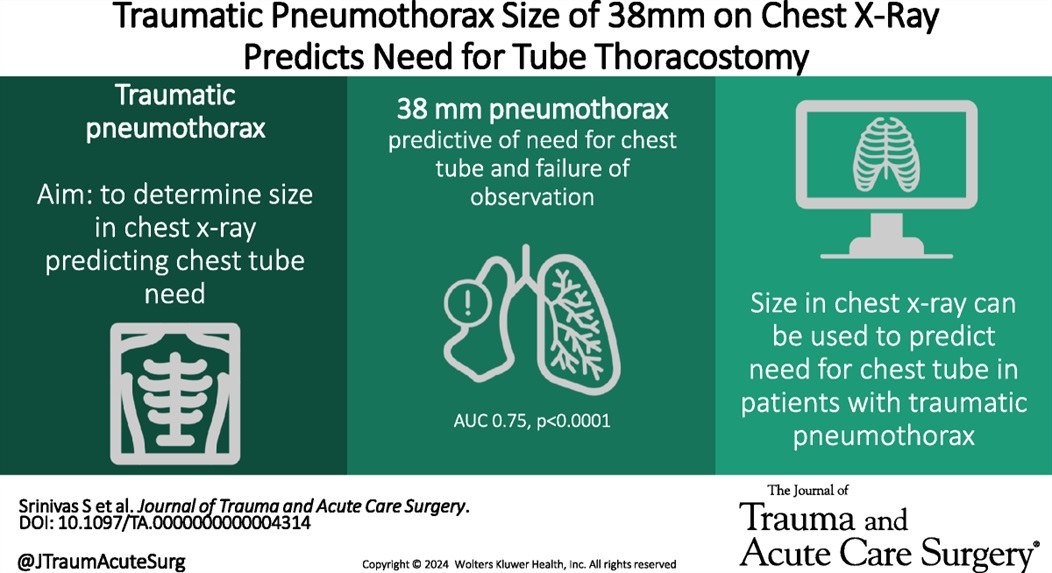
Using chest X-ray to predict tube thoracostomy in traumatic pneumothorax: A single-institution retrospective review
Srinivas, Shruthi MD; Henderson, Katelyn BS; Bergus, Katherine C. MD; Jacobs, Ayanna MD; Baselice, Holly MPH; Donnelly, Edwin MD, PhD; Valdez, Carrie MD; Tracy, Brett M. MD; Coleman, Julia R. MD, MPH
Journal of Trauma and Acute Care Surgery 97(1):p 82-89, July 2024. | DOI: 10.1097/TA.0000000000004314
Category: Trauma
Keywords: TBI, hypotension, vasopressors (PubMed Search)
Posted: 7/29/2024 by Robert Flint, MD
Click here to contact Robert Flint, MD
In this prospective, observational study of trauma patients with isolated head trauma, 62% of patients developed post-intubation hypotension. Comparing patients receiving hypertonic saline, vasopressors, crystalloid, or blood those receiving hypertonic saline and vasopressors had less post-intubation hypotension.
TBI patients who develop hypotension have worse outcomes. This study reminds us the use of vasopressors in trauma patients to maintain blood pressure is appropriate in the correct circumstances.
Anand, Tanya MD, MPH, MT(ASCP); Hejazi, Omar MD; Conant, Madolyn BS; Joule, Dylan BS; Lundy, Megan MD; Colosimo, Christina DO, MS; Spencer, Audrey MD; Nelson, Adam MD; Magnotti, Lou MD; Joseph, Bellal MD
Journal of Trauma and Acute Care Surgery 97(1):p 112-118, July 2024. | DOI: 10.1097/TA.0000000000004306
Category: Trauma
Keywords: Txa, TBI, seizure, risk (PubMed Search)
Posted: 7/21/2024 by Robert Flint, MD
Click here to contact Robert Flint, MD
According to this study, no TXA 2g bolus was not found to increase the number of seizures in TBI pts.
TXA has been shown to improve mortality in inter cranial hemorrhage trauma patients if given within 2 hours. TXA is also known to lower seizure threshold. This study was a secondary analysis of a larger study comparing placebo to 1 g TXA bolus plus 8 hour infusion or 2g bolus TXA in the prehospital setting. There was no difference in the number of pts experiencing seizure or outcome in those receiving the 2g bolus of TXA.
The Association Between Tranexamic Acid and Seizures in Moderate or Severe Traumatic Brain Injury
David V. Deshpande BS a, W. Ian McKinley MD, MS b, Andrew J. Benjamin MD, MS c, Martin A. Schreiber MD, FACS, FCCM d, Susan E. Rowell MD, MBA, MCR
Volume 301, September 2024, Pages 359-364 https://doi.org/10.1016/j.jss.2024.06.035
Category: Trauma
Keywords: facial trauma, orbit, fracture (PubMed Search)
Posted: 7/7/2024 by Robert Flint, MD
(Updated: 12/14/2025)
Click here to contact Robert Flint, MD
Patient struck in left eye. The patient was asked to look up during exam and this is the finding. What imaging modality would you order if so inclined, what is the injury, and what is the disposition/plan?

Concern for a left orbital “blowout” fracture with muscle entrapment. Also called the trapdoor fracture. CT is the imaging modality of choice not plain films. This injury requires emergent consultation with a face surgeon (plastics, ENT or oculoplastics.). Right orbital fracture in the photo below.
-668ade5e780f0.jpg)
1.https://www.researchgate.net/figure/Girl-with-blowout-fracture-of-the-left-orbit-and-enophthalmos_fig1_351847537
2.|The Lancet. VOLUME 395, ISSUE 10221, P370, FEBRUARY 01, 2020
Paul Geraeds Kemps, BSc Michaël Herman Frank, MD
Published: February 01, 2020DOI:https://doi.org/10.1016/S0140-6736(19)33223-4
Category: Trauma
Keywords: Ketamine intranadal fentanyl trauma pain (PubMed Search)
Posted: 6/30/2024 by Robert Flint, MD
(Updated: 12/14/2025)
Click here to contact Robert Flint, MD
192 trauma patients who were receiving pre-hospital fentanyl for moderate to severe pain were randomized to placebo or intranasal 50 mg ketamine as an adjunct for pain control. There was no difference between the two groups in decrease in pain scale.
The authors concluded: “In our sample, we did not detect an analgesic benefit of adding 50 mg intranasal ketamine to fentanyl in out-of-hospital trauma patients.”
Jason T. McMullan, MD, MS Christopher A. Droege, PharmD Kathleen M. Chard, PhD Kim Ward Hart, MA
Christopher J. Lindsell, PhD Richard J. Strilka, MD, PhD
Open AccessPublished:June 12, 2024DOI:https://doi.org/10.1016/j.annemergmed.2024.04.018
Category: Trauma
Keywords: troponin fall geriatric trauma (PubMed Search)
Posted: 6/20/2024 by Robert Flint, MD
(Updated: 12/14/2025)
Click here to contact Robert Flint, MD
A prospective European study of patients over age 65 presenting with a ground level fall obtained troponin levels to ascertain if myocardial infarction was a cause of the ground level fall. Troponin levels were elevated in a majority of patients however only 0.5% were defined as having a myocardial infarction. Of the 3% who died within 1 year, troponin was found to be higher than those that survived the one-year study period. The authors concluded “Our data do not support the opinion that falls may be a common presenting feature of MI. We discourage routine troponin testing in this population. However, hs-cTnT and hs-cTnI were both found to have prognostic properties for mortality prediction up to 1?year.”
Diagnostic and prognostic value of cardiac troponins in emergency department patients presenting after a fall: A prospective, multicenter study
Tanguy Espejo, Lukas Terhalle, Alexandra Malinovska MD, Henk B. Riedel MD, Laura Arntz MD, Livia Hafner, Karen Delport-Lehnen MD, Joanna Zuppinger MD,
First published: 26 March 2024
Academic Emergency Medicine
Category: Trauma
Keywords: hemorrhage, tourniquet, innovation, Delphi (PubMed Search)
Posted: 6/9/2024 by Robert Flint, MD
(Updated: 6/16/2024)
Click here to contact Robert Flint, MD
Appropriately, a great deal of time and energy is being expended to educate on the use of tourniquets to prevent mass hemorrhage. Are the current generation of tourniquets the best that we can have? These authors performed a Delphi study to assess needs with tourniquet design.
They concluded the next generation of tourniquets should have the following: “Capable of being used longer than 2 hours, applied and monitored by anyone, data displays, semiautomated capabilities with inherent overrides, automated monitoring with notifications and alerts, and provide recommended actions.”
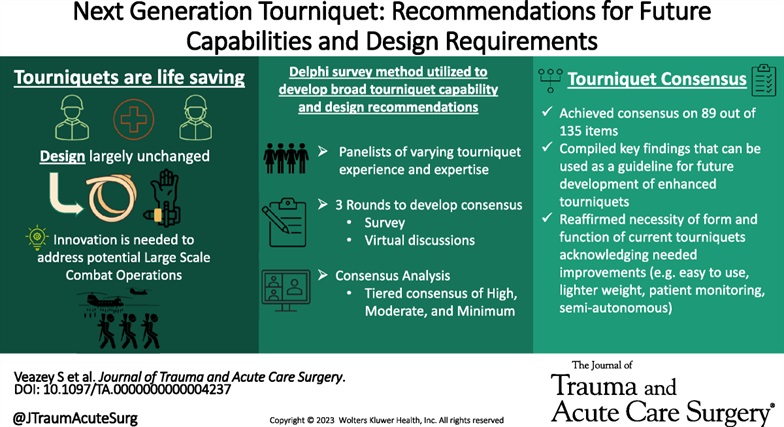
Veazey, Sena R. MS; Mike, Jared F. PhD; Hull, Darke R. BS; Ryan, Kathy L. PhD; Salinas, Jose PhD; Kragh, John F. Jr MD. Next-generation tourniquet: Recommendations for future capabilities and design requirements. Journal of Trauma and Acute Care Surgery 96(6):p 949-954, June 2024. | DOI: 10.1097/TA.0000000000004237
Category: Trauma
Keywords: BIG, transfer, head trauma, brain injury (PubMed Search)
Posted: 6/9/2024 by Robert Flint, MD
(Updated: 12/14/2025)
Click here to contact Robert Flint, MD
This study used the modified Brain injury Guidelines retrospectively to assess whether the guidelines would have saved transfers to their level one facility safely. They concluded the guidelines would have effectively prevented unnecessary mBIG 1 and mBIG2 transfers with no patient harm.
TABLE 1 - Modified Brain Injury Guidelines Radiologic Stratification, as per Kahn et al.
| mBIG 1 | mBIG 2 | mBIG 3 | |
|---|---|---|---|
| Skull fracture | No | Non-displaced | Displaced |
| SDH | ?4 mm | 4–7.9 mm | ?8 mm |
| EDH | No | No | Yes |
| SAH | ?3 sulci and <1 mm | Single hemisphere or 1–3 mm | Bihemisphere or >3 mm |
| IVH | No | No | Yes |
| IPH | ?4 mm | 4–7.9 mm | ?8 mm or multiple |
EDH, epidural hematoma; IPH, intraparenchymal hemorrhage; IVH, intraventricular hemorrhage; SAH, subarachnoid hemorrhage.
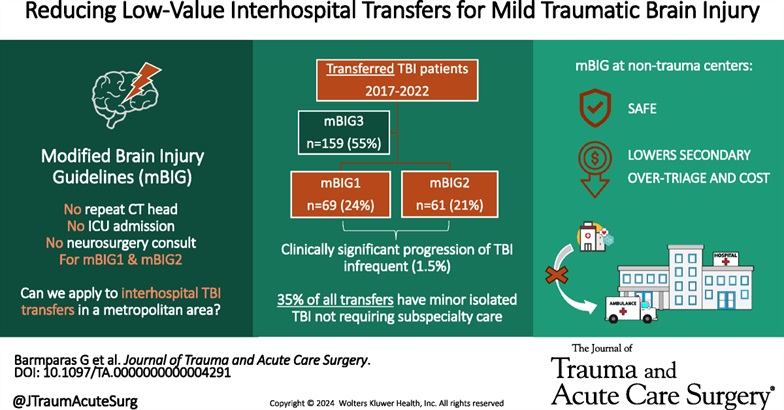
Shen, Aricia MD; Mizraki, Nathaniel MD; Maya, Marcel MD; Torbati, Sam MD; Lahiri, Shouri MD; Chu, Ray MD; Margulies, Daniel R. MD; Barmparas, Galinos MD. Reducing low-value interhospital transfers for mild traumatic brain injury. Journal of Trauma and Acute Care Surgery 96(6):p 944-948, June 2024. | DOI: 10.1097/TA.0000000000004291
Category: Trauma
Posted: 5/29/2024 by Robert Flint, MD
(Updated: 6/1/2024)
Click here to contact Robert Flint, MD
In this Scandinavian study looking at 2,362 head injury patients on oral anticoagulants, the authors found only 5 cases of delayed hemorrhage and none of the five underwent neurosurgery. The authors concluded:
“In patients with head trauma, on oral anticoagulation, the incidence of clinically relevant delayed intracranial hemorrhage was found to be less than one in a thousand, with detection occurring four days or later after initial presentation.”
It would appear based on this study and others that it is safe to discharge these patients with a normal head CT and giving strict return precautions for headache, nausea, vomiting or other changes.
André, L., Björkelund, A., Ekelund, U. et al. The prevalence of clinically relevant delayed intracranial hemorrhage in head trauma patients treated with oral anticoagulants is very low: a retrospective cohort register study. Scand J Trauma Resusc Emerg Med 32, 42 (2024). https://doi.org/10.1186/s13049-024-01214-0
Category: Trauma
Keywords: Lefort, facial, trauma, fracture (PubMed Search)
Posted: 5/26/2024 by Robert Flint, MD
(Updated: 12/14/2025)
Click here to contact Robert Flint, MD
On exam, assess for facial instability and airway patency. CT scan is the imaging of choice. The higher the number, the more complex the fracture, the more unstable and the more difficult the airway managment will be. Look for open lacerations or blood in the sinuses and treat with antibiotics if these are found. Consult ENT or plastics urgently for further management.
The reference is a nice review of these fractures
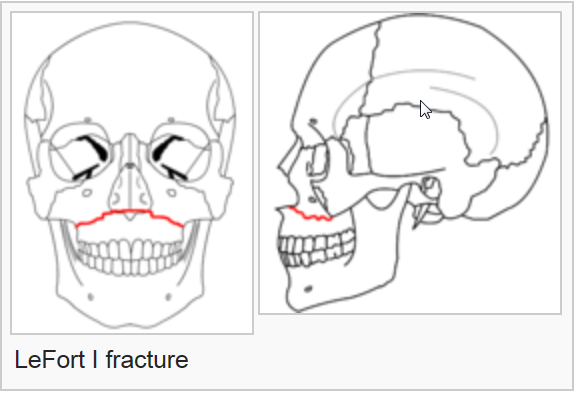
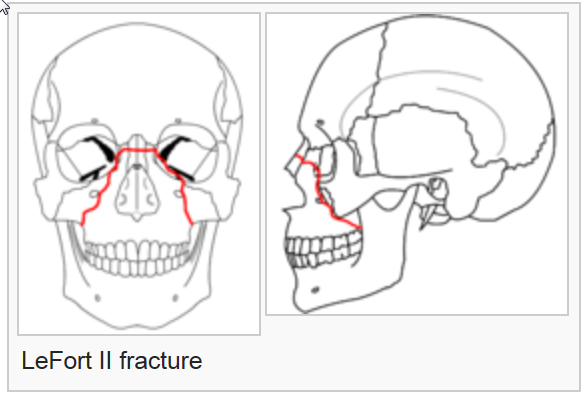
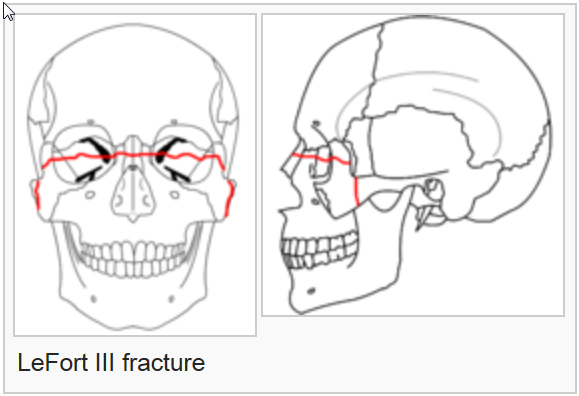
Category: Trauma
Keywords: vasopressor, hemorrhage, shock, trauma (PubMed Search)
Posted: 5/19/2024 by Robert Flint, MD
(Updated: 12/14/2025)
Click here to contact Robert Flint, MD
In this podcast, the concept of vasopressor use in hemorrhagic shock is discussed. Key take away points:
Category: Trauma
Posted: 5/12/2024 by Robert Flint, MD
(Updated: 12/14/2025)
Click here to contact Robert Flint, MD
Hemodynamic instability in trauma patients is most often associated with hemorrhagic shock, however, there is an entity known as brain injury associated shock (BIAS). BIAS is thought to be associated with catecholamine surges secondary to brain injury. BIAS is found in both isolated head injury pts as well as multi-trauma patients. Studies have identified BIAS in 13% of adult trauma patients and up to 40% of pediatric major trauma patients.
We know hypotension in brain injury worsens outcome. We should assume hemorrhagic etiology until we prove otherwise. Once we suspect BIAS and have excluded hemorrhagic etiology our strategy should switch to blood pressure support using non-blood product management.
Partyka C, Alexiou A, Williams J, Bliss J, Miller M, Ferguson I. Brain Injury Associated Shock: An Under-Recognized and Challenging Prehospital Phenomenon. Prehospital and Disaster Medicine. Published online 2024:1-6. doi:10.1017/S1049023X24000359
Category: Trauma
Keywords: trauma, blunt, cardiac injury, shock, thoracic (PubMed Search)
Posted: 5/5/2024 by Robert Flint, MD
Click here to contact Robert Flint, MD
Blunt Cardiac Injury is a continuum from asymptomatic, not clinically relevant to catastrophic, life ending disease . Consider blunt cardiac injury in patients with significant force to the chest wall or sudden deceleration injuries (motor vehicle crashes, motorcycle crashes, falls from height etc.). This algorithm is helpful when working up patients suspected of having significant blunt cardiac injury.
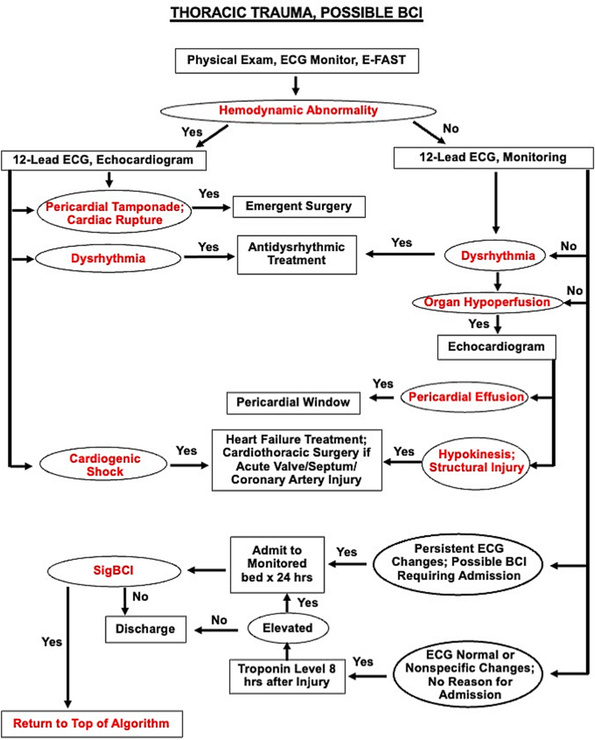
Biffl, Walter L. MD; Fawley, Jason A. MD; Mohan, Rajeev C. MD. Diagnosis and management of blunt cardiac injury: What you need to know. Journal of Trauma and Acute Care Surgery 96(5):p 685-693, May 2024. | DOI: 10.1097/TA.0000000000004216
Category: Trauma
Posted: 4/24/2024 by Robert Flint, MD
(Updated: 12/14/2025)
Click here to contact Robert Flint, MD
A small study retrospectively looking at recorded calls to a level 1 trauma center transfer line specifically looking at patients who died or were discharged to hospice without surgical intervention found only 10% had goals of care discussed prior to transfer. Most were brain hemorrhage patients.
As a transferring facility, clearly outlining goals of care and addressing futility of care can have a major impact on trauma transfers and the cost and family burden associated with transfers.
Trenga-Schein, Nellie BA; Zonies, David MD, MPH, MBA, FACS, FCCM, FACHE; Cook, Mackenzie MD, FACS
Journal of Trauma and Acute Care Surgery 96(4):p 583-588, April 2024. | DOI: 10.1097/TA.0000000000004215
Category: Trauma
Posted: 4/21/2024 by Robert Flint, MD
Click here to contact Robert Flint, MD
PECARN has a decision tool to identify blunt trauma patients under age 18 who are low probability for important intra-abdominal injuries. The questions to ask are:
Answering no to all yields <0.1% chance of intra-abdominal trauma requiring intervention. (See MedCalc link for other calculations)
A prospective validation study in the Lancet yielded 100% sensitivity and negative predictive value in 7542 patients under age 18
This tool can likely be used to guide imaging choices in pediatric blunt abdominal trauma patients
Category: Trauma
Posted: 4/14/2024 by Robert Flint, MD
(Updated: 12/14/2025)
Click here to contact Robert Flint, MD
This study looked at survival pre and post implementation of an airway guideline for prehospital traumatic brain injury (TBI) patients who received positive pressure airway interventions. The guideline “focused on the avoidance and aggressive treatment of hypotension and 3 airway-related goals: (1) prevention or treatment of hypoxia through early, high-flow oxygen administration; (2) airway interventions to optimize oxygenation or ventilation when high-flow oxygen was insufficient; and (3) prevention of hyperventilation or hypocapnia by using ventilation adjuncts (ie, rate timers, flow-controlled ventilation bags, end-tidal carbon dioxide monitoring).”
Post implementation, survival to admission increased in all severity levels of TBI and in the most severely injured, survival to discharge improved.
Useful for those involved in prehospital education and as a reminder for in hospital airway management in TBI patients.
Gaither JB, Spaite DW, Bobrow BJ, et al. EMS Treatment Guidelines in Major Traumatic Brain Injury With Positive Pressure Ventilation. JAMA Surg. 2024;159(4):363–372. doi:10.1001/jamasurg.2023.7155
Category: Trauma
Keywords: Trauma, blood pressure, shock index, predictor, mortality (PubMed Search)
Posted: 4/8/2024 by Robert Flint, MD
Click here to contact Robert Flint, MD
Traditionally, a systolic blood pressure (SBP) of 90 has been used as a marker of severe illness in trauma patients. This study looked at a large database and found shock index (SI) and systolic blood pressure were the best predictors of early mortality in trauma patients.
They found:
prehospital SI 0.9 and SBP 110,
ED SI 0.9 and SBP 112,
and
in elderly
prehospital SI 0.8 SBP 116
ED SI 0.8 SBP 121
were the cutoffs to predict early mortality.
We should rethink our protocols and approach to trauma patients using a higher systolic blood pressure than 90. Also note elderly had a different number than younger trauma patients.
April MD, Fisher AD, Rizzo JA, Wright FL, Winkle JM, Schauer SG. Early Vital Sign Thresholds Associated with 24-Hour Mortality among Trauma Patients: A Trauma Quality Improvement Program (TQIP) Study. Prehosp Disaster Med. 2024 Apr 2:1-5. doi: 10.1017/S1049023X24000207. Epub ahead of print. PMID: 38563282.
Category: Trauma
Keywords: Marker, penetrating trauma, radiopaque (PubMed Search)
Posted: 4/7/2024 by Robert Flint, MD
(Updated: 12/14/2025)
Click here to contact Robert Flint, MD
Using radiopaque markers such as paperclips to mark penetrating wounds prior to radiographs has been taught in trauma bays for decades. This article points out there is no evidence to support this practice and is purely based on expert opinion. With the heavy use of CT imaging to assess wound tracks, the use of markers on plain films appears to be of limited utility.
Sarfaraz K, Nemeth J, Bahreini M. The use of radiopaque markers is medical dogma. Acad Emerg Med. 2024 Feb;31(2):193-194. doi: 10.1111/acem.14858. Epub 2024 Feb 6. PMID: 38112251.
Category: Trauma
Keywords: Alcohol, withdrawal, trauma, protocol, sparing (PubMed Search)
Posted: 3/24/2024 by Robert Flint, MD
(Updated: 12/14/2025)
Click here to contact Robert Flint, MD
This study compared admitted trauma patients with alcohol withdrawal or those at risk of withdrawal before and after a benzodiazepine sparing protocol (using clonidine and gabapentin) was initiated. They found a lower daily CIWA score and significantly less lorazepam use in the benzodiazepines sparing group. This sparing protocol appears to be safe and effective.
McCullough, Mary Alyce MD; Miller, Preston R. III MD; Martin, Tamriage MD; Rebo, Kristin A. PharmD; Stettler, Gregory R. MD; Martin, Robert Shayn MD; Cantley, Morgan PharmD; Shilling, Elizabeth H. PhD; Hoth, James J. MD, PhD; Nunn, Andrew M. MD
Journal of Trauma and Acute Care Surgery 96(3):p 394-399, March 2024. | DOI: 10.1097/TA.0000000000004188
Category: Trauma
Keywords: Geriatric trauma, outcome, hospice (PubMed Search)
Posted: 3/17/2024 by Robert Flint, MD
(Updated: 12/14/2025)
Click here to contact Robert Flint, MD
This was a database study of nearly 2 million trauma patients over age 65 who were discharged looking at all levels of trauma centers. The authors found:
“Dominance analysis showed that proportion of patients with Injury Severity Score of >15 contributed most to explaining hospice utilization rates (3.2%) followed by trauma center level (2.3%), proportion White(1.9%), proportion female (1.5%), and urban/rural setting (1.4%).”
Level one centers had the lowest level of discharge to hospice. The authors felt: “As the population ages, accurate assessment of geriatric trauma outcomes becomes more critical. Further studies are needed to evaluate the optimal utilization of hospice in end-of-life decision making for geriatric trauma.”
Fakhry, Samir M. MD, FACS; Shen, Yan PhD; Wyse, Ransom J. MPH; Garland, Jeneva M. PharmD; Watts, Dorraine D. PhD
Journal of Trauma and Acute Care Surgery 94(4):p 554-561, April 2023. | DOI: 10.1097/TA.0000000000003883
